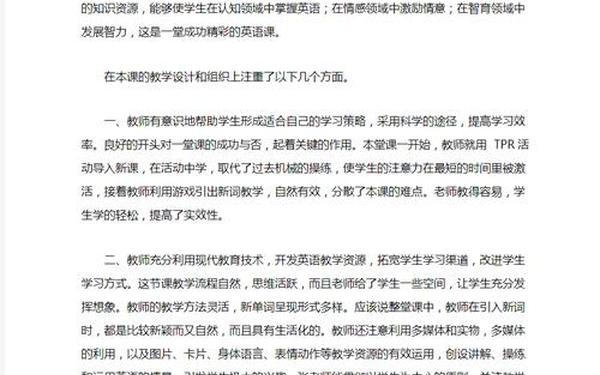以下是一份适用于初中英语课堂的万能评课稿模板(英语版),结合了多个优秀课例的设计亮点,可供参考并灵活调整:
Universal Template for Junior High School English Class Evaluation
Class: [Grade Level]
Topic: [Lesson Topic]
Teacher: [Teacher's Name]
1. Overall Impression
The lesson demonstrated a student-centered approach with clear alignment to the curriculum objectives. The teacher effectively integrated language skills (listening, speaking, reading, writing) and fostered critical thinking through interactive activities. The use of scaffolding techniques ensured gradual progression from simple to complex tasks, making the lesson both engaging and educational.
2. Lesson Structure
(1) Warm-up & Lead-in
Innovative Hook: The teacher utilized [songs/videos/real-life scenarios] to introduce the topic, such as [specific example, e.g., "using a video of students' daily activities to contextualize the past continuous tense"], which immediately captured students' attention and activated prior knowledge.
Objective Clarity: The learning goals (e.g., mastering [grammar point/target vocabulary]) were explicitly stated, ensuring students understood the purpose of the lesson.
(2) Presentation & Practice
Multisensory Input: Visual aids (e.g., half-covered pictures for guessing games) and auditory tools (e.g., dialogues) were combined to reinforce language input. This catered to diverse learning styles.
Interactive Drills: Pair work, group discussions, and role-plays (e.g., ["A interviews B, C, D with rotating partners"]) promoted peer interaction and reduced reliance on traditional teacher-led instruction.
Scaffolded Tasks: Activities progressed from controlled practice (e.g., sentence completion) to semi-structured tasks (e.g., creating dialogues), culminating in freer production (e.g., writing a short paragraph).
(3) Consolidation & Extension
Gamification: Games like ["Guess the Action"] or ["Golden Egg Smash"] provided high-energy review sessions, enhancing retention through play.
Real-world Application: Tasks such as [describing hometowns/comparing cities] connected language use to students' lives, fostering authentic communication.
(4) Assessment & Homework

Formative Feedback: The teacher provided timely corrections during activities (e.g., recasting errors in grammar/pronunciation) while encouraging student self-evaluation.
Differentiated Assignment: Homework options (e.g., [researching a city/writing a reflective journal]) allowed for personalized learning paths.
3. Strengths
Tech Integration: Multimedia resources (e.g., videos, interactive PPTs) enriched the lesson, making abstract concepts (e.g., comparative adjectives) tangible.
Differentiated Instruction: Activities accommodated varying proficiency levels. For example, [advanced students guided peers in group tasks].
Cultural & Emotional Engagement: The lesson incorporated [local culture/values like teamwork], building students' confidence and global awareness.
4. Areas for Improvement
Pacing: Some tasks required tighter time management to ensure all students completed activities fully.
Error Correction: Balancing fluency and accuracy could be enhanced by addressing recurring errors collectively post-activity.
Inclusive Participation: Additional strategies (e.g., randomized name selection) might ensure quieter students contribute equally.
5. Conclusion
This lesson exemplified best practices in EFL teaching, blending innovation with pedagogical rigor. The teacher’s ability to [adapt materials/create a joyful learning environment] significantly boosted student motivation and outcomes. Minor adjustments in [timing/feedback methods] could further elevate its effectiveness.
Key Phrases for Adaptation
For Grammar Lessons: "contextualized grammar drills," "situational practice."
For Reading/Writing: "text analysis frameworks," "brainstorming mind maps."
For Speaking: "think-pair-share," "debate scaffolds."
此模板灵活覆盖课堂设计、活动类型、技术应用及反馈机制,适用于不同课型(如语法课、听说课、阅读课)。用户可根据实际教学场景替换方括号中的内容,并参考标注的来源进一步细化设计。


